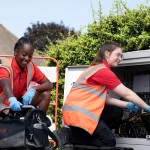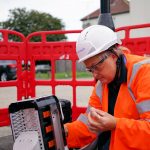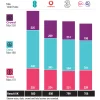No More Gov EIS Tax Relief for Community Benefit Broadband ISPs UPDATE
A new ruling by HMRC, which appears to say that UK broadband ISPs acting as a Community Benefit Societies (CBS) to build their own local networks can no longer make use of tax breaks under the Enterprise Investment Scheme (EIS), could have serious repercussions for “full fibre” projects in rural areas.
The situation first came to our attention last year (here) after the well-known and widely respected B4RN project, which since 2012 has been busy running a community built and funded 1Gbps Fibre-to-the-Home (FTTH) broadband network to rural premises in several counties, stopped processing new EIS1 forms for investments made into the ISP.
B4RN’s project has been a huge success, not least due to the way in which they’ve encouraged volunteers in each area to help build the network (usually in exchange for shares instead of cash). The model relies on local landowners (e.g. farmers) being generous and agreeing to waive their right to payment under a wayleave (access) agreement, which enables the fibre to be cheaply dug through their land.
Advertisement
At the last count well over 5,000 connections had been made to the network and their approach has been copied by a growing number of other community FTTH builds across the UK. As part of this effort B4RN have also been a member of the Government’s EIS scheme since 2011, which offers tax breaks to individual investors who buy new shares in the company.
B4RN’s Community Focus
As a community benefit society B4RN must operate for the benefit of its defined community rather than for the benefit of its members and shareholders. B4RN can pay interest on its shares but only at a level necessary to attract and maintain the investment needed to fund the network construction and operation. Any surplus funds must be used to benefit the community and not be distributed to shareholders.
Anybody who invests in B4RN (usually community members) understands that the operator is all about encouraging communities to help build their own network. This in turn helps to make an otherwise hugely expensive process much more viable and that means fewer areas requiring state aid in the future. However their approach has now come into conflict with the new Finance Act 2018, which introduced some changes to the EIS scheme.
Last year HMRC announced that they would be testing B4RN’s compliance against these new conditions, in particular the “risk to capital” rule.
FA2018 Extract – Risk-to-capital condition
(1) The risk-to-capital condition is met if, having regard to all the circumstances existing at the time of the issue of the shares, it would be reasonable to conclude that-
(a) the issuing company has objectives to grow and develop its trade in the long-term, and
(b) there is a significant risk that there will be a loss of capital of an amount greater than the net investment return.
NOTE: The latter condition is to be considered for investors generally, rather than any specific investor.
At the time B4RN said they were “confident” of remaining eligible for EIS but in the meantime opted to play it safe by putting a pause on processing any new EIS1 forms for investments made into their company (covering the period from 15th March 2018 to present), at least until they knew the outcome.
Advertisement
After some delay (apparently due to one of HMRC’s people going off on long term sick leave) B4RN has now got their answer and it’s not good news. Effectively the provider has been told that, because their approach is “fundamentally uncommercial” (i.e. not setup to make a profit), they no longer meet the necessary conditions and can no longer benefit from the EIS.
Barry Forde, CEO of B4RN, told ISPreview.co.uk:
“The big thing about it is that they are now saying that Community Benefit Societies (CBS) don’t comply with the rules around trading which they define as having to make a cash profit, instead aiming to benefit the community, so not eligible for EIS tax relief.
As you know there are a load of CBSs setup or being setup to do the rural broadband stuff, similar to B4RN but in a much earlier phase where EIS eligibility is very much more important. It’s not really much of an issue for B4RN now as we would have hit the upper limits over the next year anyway so were factoring no EIS into our medium term plans. But for start-ups it could be a killer.
I really don’t think HMG has thought this one out. For the full fibre everywhere ambition to reach the last few percent community involvement is going to have to play a major part. If landowners are going to agree to laying ducts across their fields and waiving any wayleave charges they have to be convinced it’s a community project and no one is going to make any money.
The HMRC ruling means that this structure cannot be used if EIS is needed (and 30% tax relief is a big incentive). But if groups setup as anything that meets HMRC’s rules for profitability they wont get landowners support. So where we go from here is anyone’s guess.”
Barry’s expectation now is that if communities cannot do the roll-out through this approach then the only alternative is more government grants, which seems like a potentially much more costly solution than providing general support to help communities do it themselves. This seems unlikely to help the Government’s aspiration for “nationwide” coverage of full fibre by 2033.
We have asked the Government for a comment but the weekend is likely to delay their response until early next week. Meanwhile B4RN has kindly given us permission to re-print the letter below (bottom).
UPDATE 14th Feb 2019
Advertisement
After three weeks the HM Treasury has finally responded to provide a comment, which sidesteps the issue to talk about their voucher schemes instead. Vouchers a very different type of mechanism that creates a dependence upon direct public support, which is not as flexible. Operators like B4RN would naturally prefer to use both wherever possible, but for now the EIS route remains closed.
A Government Spokesperson told ISPreview.co.uk:
“We are committed to supporting community broadband schemes, which is why we subsidise broadband installation through our Better Broadband and Gigabit Broadband Voucher schemes, and allocated £200 million in last year’s Budget to pilot innovative approaches to deploying full fibre in rural locations.
The Enterprise Investment Scheme (EIS) is designed to encourage investment in high risk, early stage companies which face the biggest challenges in accessing the capital needed to grow and scale up.”
ORIGINAL LETTER FOLLOWS

Mark is a professional technology writer, IT consultant and computer engineer from Dorset (England), he also founded ISPreview in 1999 and enjoys analysing the latest telecoms and broadband developments. Find me on X (Twitter), Mastodon, Facebook, BlueSky, Threads.net and Linkedin.
« Vodafone Cough to Using Some of Three UK’s Mobile Spectrum


















































Comments are closed